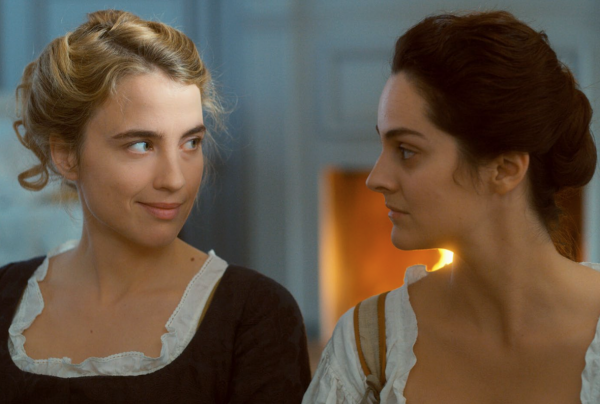Portrait of a Lady on Fire, the newest film from French writer/director Celine Sciamma, is one of the more unique love stories of the 2019 movie season. Currently playing in New York and LA, and rolling out nationwide on February 14, 2020, it concerns the burgeoning relationship between a female artist in 18th century France and her model, a reluctant bride-to-be. What makes it so special is not just their affair, but the way art plays such a part in it. The two women share a bond that is physical, certainly, but their connection over the aesthetics of artistic expression becomes the truer core of their bond.
Both women are fighting for their place in a patriarchal society. Marianne (Noemi Merlant) is a talented painter, but few women are artists and it makes her an oddity. While being transported to an isolated island in Brittany for a commission, the rolling waves rock the rowboat she’s in and sends the crate with her blank canvases into the drink. No man dives in to save her effects, so Marianne must do it herself.
The experiences Heloise (Adele Haenel) has with men aren’t much better. She comes from money but her mother (Valeria Golina) treats her as a virtual promissory note, contracting her to a marriage with a Milanese nobleman her daughter has never met. The matriarch has hired Marianne to paint her daughter to entice her husband with a beautiful portrait to seal the deal. Not exactly striking a blow for feminism, to say the least.

Luana Bajrami and Noemie Merlant
Soon after arriving on the island, Marianne discovers that Heloise won’t sit for the portrait as a protest against the marriage arrangement. Thus, the artist must pretend to be a visitor and study Heloise’s features while sharing walks with her around the perimeter. At first, the two mix like oil and water. Heloise is surly and closed off, while Marianne is flummoxed by her lack of artistic access. She does her best to visually log her subject’s physical characteristics, but when she puts it all on canvas, the final result is naïve and uninformed. Heloise takes offense at the scheme and the painting, deriding its mediocre likeness. Agreeing with Heloise’s withering assessment, Marianne destroys the painting.
That softens Heloise, and they start a new, proper painting. During the sittings, they share stories, opinions, and their fears about their place in the world. As the two learn to trust each other, they discover a shared zeal for art, music, and literature. (They spend time discussing Vivaldi and the story of Orpheus and Eurydice.) As Marianne gets to know Heloise, they become friends, and eventually, lovers. The artist learns to truly “see” who her subject is, ensuring a successful and better-informed portrait.
And as their eyes are opened to each other and the world around them, the two come to better understand other versions of inequality too. The household servant Sophie (Luana Bajrami) becomes more than just an attendant, but a friend as well. The film strikes a chord against the caste system, even one that often lets women traffic in the same prejudices as men do when it comes to matters of station.

Adele Haenel
Sciamma shrewdly weaves in commentary about equality, economics, and societal norms throughout the story. And as her two lovers broaden their expressiveness, so too does Sciamma’s direction. Her camera goes from static to kinetic, echoing their liberation. As their passion builds, so too does the intensity in the music on the soundtrack and the verve in the editing. Both actresses do superb work, with Haenel particularly impressive in her arc from pouty girl to passionate woman.
Hopefully, as the film broadens its audience, it won’t become known primarily as a film about a lesbian affair. It is not that simple, any more than past films like Personal Best (1981), Bound (1996), or Blue is the Warmest Colour (2013) were strictly about a same-sex topic in their day. Sciamma’s film is about two women bonding over love, art, and expression. It’s a beautiful portrait rendered by a truly exquisite filmmaker.
View the trailer for Portrait of a Lady on Fire below:

